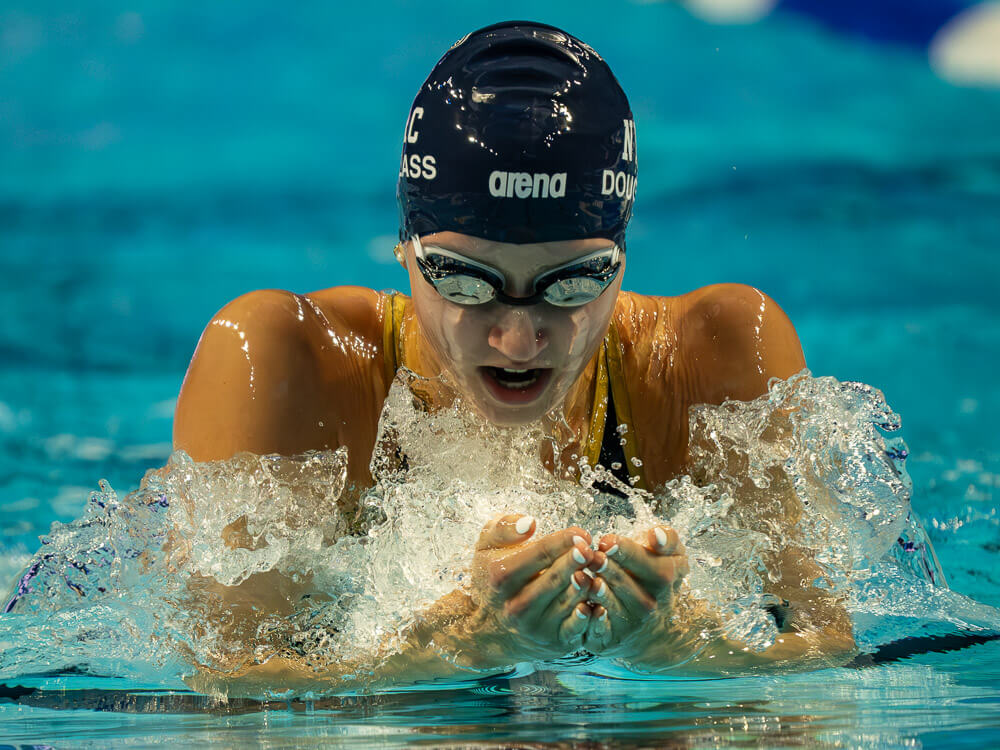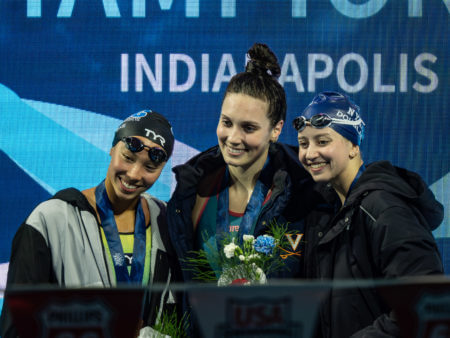For Kate Douglass, American Record is Another Step Toward Olympic Stardom

For Kate Douglass, American Record is Another Step Toward Olympic Stardom
During the early days of her college career at the University of Virginia and before she broke out as an accomplished international performer, Kate Douglass had to find a niche in which she could qualify for international competition and win medals for the United States. At first, her event was the 200 IM, as Douglass qualified for the Tokyo Games in that race while missing by one spot in both the 100 butterfly and 400 freestyle relay. She ended up winning a strong bronze in her lone event at her Games.
But the next year, when Douglass won another individual medal at a major championship meet, it came in the 200 breaststroke, an event she had not even contested one year previously at the U.S. Olympic Trials. Moreover, Douglass did not even try to qualify for the World Championships in the individual medley. In total, her first World Championships in Budapest produced three bronze medals, in the 200 breast plus a pair of 400 free relays (women’s and mixed).
Those were strong results for a swimmer’s first two major meets, but entering 2023, the wider swimming community was still uniformed as to the full scope of Douglass’ abilities. However, the college scene provided a hint: during her last two seasons racing for the Cavaliers, Douglass became the NCAA champion and fastest swimmer in history in four different events, the combination of which few (if any) swimmers had ever attempted at the collegiate level: the 50 free, 100 fly, 200 breast and 200 IM.
A jaw-dropping college finale saw her demolish the all-time record in the 200 IM by almost two seconds, win a 100 fly showdown with Olympic champion Maggie Mac Neil and world champion Torri Huske and lower her 200 breast record for the fourth time in 365 days. Douglass was the central star in Virginia’s third consecutive national title — and four months later, she would play a similar role for the United States.

Kate Douglass (right) at U.S. Nationals with Torri Huske & Alex Walsh — Photo Courtesy: Peter H. Bick
By the Fukuoka World Championships, she had become the world’s best in the 200 IM and the clear-cut top 100 freestyler in the country, having lowered her best time from 53.99 to 52.57 in one day at U.S. Nationals. She also captured silver in the 200 breast at Worlds, but fast forward another six months, and 22-year-old from Pelham, N.Y., has positioned herself for a run at gold in that event as well.
Through two days at the TYR Pro Series in Knoxville, Tenn., Douglass had posted performances uncommonly good for mid-January: a 53.12 100 free to dominate a field of America’s best and a 200 IM time trial of 2:07.89. But she saved the best for the final day, in the 200 breast, when she uncorked an enormous best time, a two-second drop that made her only the ninth woman ever under 2:20.
Douglass broke a 12-year-old American record that had belonged to Rebecca Soni with her time of 2:19.30, making her the first U.S. swimmer to set a long course national record in January since Katie Ledecky broke an 800 free world record six months out from the 2016 Olympics.
“Breaking an American record in the long course 200 breast was definitely a goal that I had but something I didn’t think I would achieve until a few months from now,” Douglass said. “I was hoping over the summer I’d be able to do something like that, but even then, I wasn’t sure if a 2:19 was ever really in my grasp, so that was super awesome to see that happen at a meet in January.”
Despite racing at a time of year when few elite performers are approaching their tapered times, Douglass saw this one coming — the best time, at least. Strong performances at the U.S. Open in early December, which followed a month of frequent travel and training she called “all over the place” had indicated to Douglass what was possible with a bit more consistency.
Now, consider that 2:19 alongside the 52-mid 100 free and 2:07-low 200 IM, with a 24-mid 50 free and 56-mid 100 fly thrown in for good measure (although Douglass suggests that she is leaning toward dropping the butterfly from her Olympic Trials program). Legitimate hopes of Olympic gold in the 200 breast alongside what she achieved in Fukuoka in the 200 IM and sprint relays: that’s a true star, clearly in the conversation of the top swimmers in the U.S. and the world.
Four years ago, a talented teen with no obvious spot on the U.S. roster. One year ago, a college yards standout with some international success but nothing close to her short course acumen. Now, she is the catalyst.
Consider the possibilities for the U.S. women’s team at the Paris Olympics. In almost all successful scenarios, Douglass is the team’s MVP or at least co-MVP. Of course, Ledecky is sure to perform admirably as usual while Regan Smith, Lilly King and Torri Huske are among the other Americans capable of multi-medal performances, but the U.S. team needs Douglass to be great.
“It’s definitely not a position I saw myself in before this past summer,” Douglass said. “It showed me that I have the potential to be a big contributor to Team USA, and that’s such a fun feeling. I think last summer, the best part was that I was able to be a contributor on a lot of relays. I love just being a reliable person for Team USA, so that’s something that I definitely am excited about possibly doing again.”
At every opportunity in recent years, Douglass has raised her level of performance. At the outset of the all-important Olympic year, that has earned her center stage.




Great article. It’s been fantastic to watch her improve and put much of the “bathtub swimmer” condescension to rest.